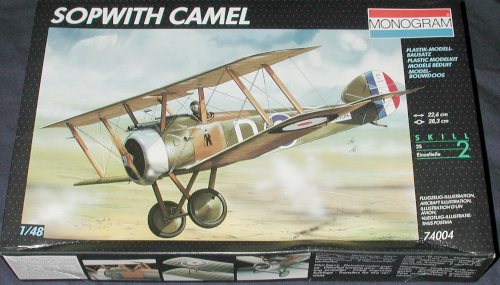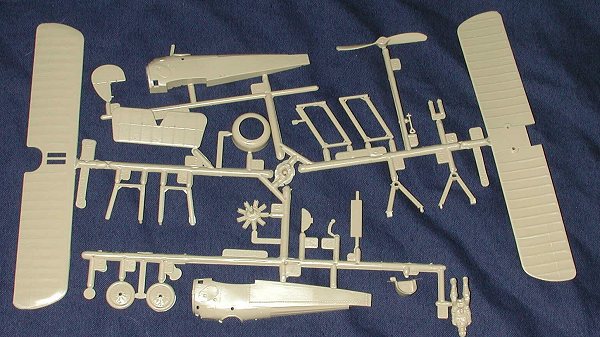
|
KIT: |
Monogram 1/48 Sopwith Camel |
|
KIT # |
74004 |
|
PRICE: |
$? |
|
DECALS: |
two options |
|
REVIEWER: |
Scott Van Aken |
|
NOTES: |
German 1991 boxing |

|
HISTORY |
|
THE KIT |

As a bit of background, many of you may not know that when Aurora went out of business in the mid 1970s, all of its assets were sold to Monogram. Monogram later cleaned up and in some cases added detail to these old Aurora molds and released these kits under the Monogram label. This kit as well as their1/48 Fokker D.VII, Se.5, A-7A, and F-111A among them are all old Aurora molds. Though almost all of these have been surpassed in recent years by more accurate and more expensive kits from China, Korea, Ukraine, and the Czech Republic. However, these old Aurora-based kits are still nicely done and a heck of a lot easier to build!
This is a German Monogram kit, which really means that they have put it in a box about three times the size of the older Monogram and Aurora boxings! The plastic is the same. What is missing from the Aurora kit is the base and extra figure. The rib effect is a bit much, but not really that bad and a bit of sanding should bring things down to a more normal representation. There is minimal cockpit detail as these planes didn't have much in there to begin with.
 The kit has held up
well as, other than a bit of flash, there are no sink areas and only
ejector pin problems are on one side of the single piece flight surfaces.
A bit of filler will take care of those. Instructions are of the
pictorial type with no written construction advice. Colors given are
generic and keyed to what seems like Revell paint numbers. Markings are
provided for two Camels, but no unit information is provided. Both are
painted in a similar manner to the box art aircraft. The decals
themselves are well printed and very matte. I've generally had silvering
problems with Revell of Germany decals. Fortunately, there are several
relatively new aftermarket sheets out there for the Camel so you don't
have to rely on what is provided in the kit. Also given is a rather crude
but easy to follow rigging diagram.
The kit has held up
well as, other than a bit of flash, there are no sink areas and only
ejector pin problems are on one side of the single piece flight surfaces.
A bit of filler will take care of those. Instructions are of the
pictorial type with no written construction advice. Colors given are
generic and keyed to what seems like Revell paint numbers. Markings are
provided for two Camels, but no unit information is provided. Both are
painted in a similar manner to the box art aircraft. The decals
themselves are well printed and very matte. I've generally had silvering
problems with Revell of Germany decals. Fortunately, there are several
relatively new aftermarket sheets out there for the Camel so you don't
have to rely on what is provided in the kit. Also given is a rather crude
but easy to follow rigging diagram.
|
CONCLUSIONS |
Should you not want to spend $30 on a new Eduard Camel, then this may well be an alternative for you. It is pretty easy to build and should look great on your shelf when done.
If you would like your product reviewed fairly and fairly quickly by a site that has over 200,000 visitors a month, please contact me or see other details in the Note to Contributors.